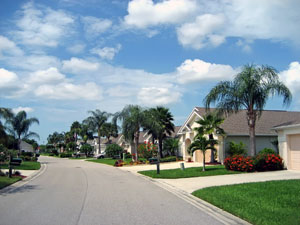LEED Point Rating System
Landscape and Exterior Design to Reduce Heat Islands
Sustainable Sites Credit 7.1

"...use light-colored / highalbedo materials (reflectance of at least 0.3) for 30% of the site's non-roof impervious surfaces."
This requirement can be met by using concrete rather than asphalt for 30% of all sidewalks, parking lots, drives and other impervious surfaces.
Albedo, which in this context is synonymous with solar reflectance, is the ratio of the amount of solar radiation reflected from a material to the amount that shines on the material. Solar radiation includes the ultraviolet as well as the visible spectrum. Generally, light-colored surfaces have a high albedo, but this is not always the case. Surfaces with lower albedos absorb more solar radiation. The absorbed radiation is converted into heat and the surface gets hotter. Where paved surfaces are required, using materials with higher albedos will reduce the heat island effect—consequently saving energy by reducing the demand for air conditioning—and improve air quality.
Concrete generally has a reflectance of approximately 0.35, although it can vary. Measured values are reported in the range of 0.4 to 0.5. For "white" portland cement, values are reported in the range of 0.7 to 0.8. New asphalt generally has a reflectance of approximately 0.05, and asphalt five or more years old has a reflectance of approximately 0.10 to 0.15. This credit is worth 1 point.
Examples of LEED credits that can be earned by utilizing concrete in the construction of parking areas:
![]() Stormwater Management Rate and Quantity
Stormwater Management Rate and Quantity
(Sustainable Sites Credit 6.1)
(Materials Credit 2)
(Materials Credit 4)
(Materials Credit 5)
![]() Landscape & Exterior Design to Reduce Heat Islands
Landscape & Exterior Design to Reduce Heat Islands
(Sustainable Sites Credit 7.1)



